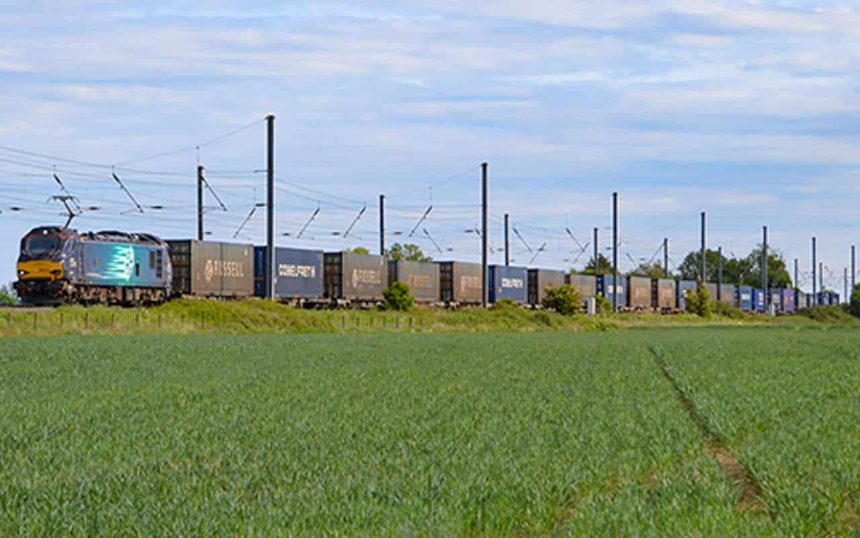Direct Rail Services has confirmed that one of its Class 88 broke new ground last week when it ran the length of the East Coast Main Line.
Last weekend, freight operator, DRS, ran a new diversionary route to enable the Class 88 locomotives to run almost the length of the ECML on electric power, as well as feeder routes that link up Daventry and Mossend.
The route normally follows the West Coast Main Line, but engineering work last weekend required a diversion.
Normally, this would have meant using a Class 66 locomotive, but a new path allowed the entire journey to be powered by the overhead lines using the Class 88 on the East Coast Main Line.
David Robinson, Deputy Director of Operations Delivery, said: “This is a fantastic new route which enables us to utilise our excellent Class 88 locomotives as usual rather than replacing them with a diesel-powered engine. Each freight train takes around 76 lorries off our roads and running on electricity allows the engines to be much more environmentally friendly and helps with our commitment to reduce CO2 emissions. We're delivering vital goods across the length of Britain and this, over 400-mile, journey highlights the benefit of rail freight and the smart use of utilising our electrified rail network.”
Where Next?
RailAdvent Plus
Get image downloads, Prints and Streaming Video
News Homepage
For the Latest Railway News
RailAdvent Online Shop
Framed Prints, DVD's / Blu-Ray's and more
LocoStop Community
Come and share your railway pictures
Mainline Steam Info
Upcoming mainline steam tours/loco movements
Direct Rail Services
Visit their website

Have you bought an electric car yet? I haven’t – Cost!
Still need vans and lorries to delivery to the end customer shop or factory etc
The Railways in this Country are run by Accountants and not by Engineers and Railwaymen. The save a penny spend a pound concept has been around for many years. Short termism has killed off many projects whilst projects that earn the Establishment Brownie points have flourished…
It would be an interesting comparison to see if France or Italy electricificaton is within the costs of Network rail program and if it is the same why do they consider electric railways still better than the ad hoc solution the UK rail system have ie Bi modal as on the GWR from Penzance to Bristol.
I wanted to see the rail lines within the TfWM boundary electrified to push TOCs to adopt bi-modal rolling stock.
That way TfWM, working with NR could push forward a Rail Emissions Zone charge and help the area to reduce regional CO2 emissions (environmental) and NOx and PM emissions (public health) and to reduce the use of diesel trains at New Street station.
XCountry is a prime candidate for bi-modal operations, all local trains should move to electrical and all suburban/regional trains should go bi-modal. Much of the rail network within the boundary is electrified anyway so the cost would not be so much, especially of a REZ charge is on place.
The Class 88 could demonstrate its dual mode versatility better if it used its diesel engine to traverse non-electrified sections. OK, 950hp isn’t much but It’s what the Class 88 is fitted with. The Stadler Euro Dual, now there’s a beast–9,000hp electric, 4,000hp diesel.
Last cost I saw was £62 billion to electrify the lot. Less than a months borrowing. As to HS2 why not take up the Chinese offer to complete it in 5 years?
COST is all important. Chancellor Rishi Sunak announced a further £27bn for major road schemes in the last budget and precisely £0 for rail electrification. Never mind: we’re all on the road to ‘net zero’ carbon emissions!
Screw cost! Does it always have to be money, money, money. Reduce the voroceous dammed military budget. It won’t miss a couple of biillion.
If they fill in short electric links they would have more flexibility. Consider the Acton (GWR mainline) to Acton wells junction a distance less than a mile. This would open up links to west coast main line.
There are some places where you cannot have electrification such as freightliner ports or other sites where the arial activity of using cranes would not allow it.
Plus the enornous cost if the installation
Simon. Very easy answer. COST. Just look at HS2 or whatever number we are up to. The cost to electrify the complete U. K. would be many billions more than HS2. I am not a fan of HS2 but can see the benefits of your suggestion.
Yes, so why isn’t their a full electrification programme across the whole of the UK?
Stadler are also manufacturing the Rail Operations Group Class 93 Locomotives and are scheduled to enter freight service from Summer this year.
https://en.wikipedia.org/wiki/British_Rail_Class_93_(Stadler)